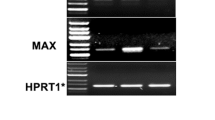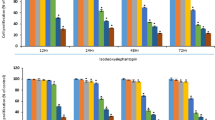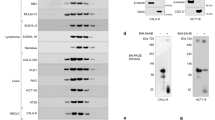Abstract
c-Myc is instrumental in the progression of Burkitt's lymphoma including HL-60 human leukemia cells. We tested fatty acids for their inhibitory effect on the DNA binding of c-Myc/Max dimeric proteins of human origin, prepared as recombinant proteins encompassing DNA binding (basic) and dimerization (HLHZip) domain, and found that those suppress proliferation and induce apoptosis of DMSO-differentiated HL-60 cells. The analyzed IC50 values of myristic acid, stearic acid, γ-linolenic acid, linoleic acid, linolenic acid and arachidonic acid by EMSA were 97(±3), 2.2(±1.2), 55(±5), 32(±2), 62(±12), 22(±2) μ M for DNA binding of recombinant c-Myc/Max, respectively. According to the results shown by XTT assay, their influence on proliferation was quite different from the rank order of IC50. Whereas the degree of influence of the unsaturated fatty acids on the proliferation of DMSO-differentiated HL-60 cells was similar, the influence of saturated fatty acids, stearic acid in particular, was very weak at same concentrations. In addition, we confirmed that these fatty acids have no influence on the expression of c-Myc in DMSO-differentiated HL-60 cells. Our experiments demonstrated that the inhibitors for the DNA binding of c-Myc/Max contribute to the downregulation of Myc-dependent proliferation and to the inducement of apoptosis, and serve as an exploration of potent new inhibitors.
This is a preview of subscription content, access via your institution
Access options
Subscribe to this journal
Receive 12 print issues and online access
$259.00 per year
only $21.58 per issue
Buy this article
- Purchase on Springer Link
- Instant access to full article PDF
Prices may be subject to local taxes which are calculated during checkout






Similar content being viewed by others
References
Henriksson M, Luscher B . Proteins of the Myc network: essential regulators of cell growth and differentiation. Adv Cancer Res 1996; 68: 109–182.
Facchini LM, Penn LZ . The molecular role of Myc in growth and transformation: recent discoveries lead to new insights. FASEB J 1998; 12: 633–651.
Prendergast GC . Mechanisms of apoptosis by c-Myc. Oncogene 1999; 18: 2967–2987.
Iritani BM, Eisenman RN . c-Myc enhances protein synthesis and cell size during B lymphocyte development. Proc Natl Acad Sci USA 1999; 96: 13180–13185.
Blackwood EM, Eisenman RN . Max: a helix–loop–helix zipper protein that forms a sequence-specific DNA-binding complex with Myc. Science 1991; 251: 1211–1217.
Prendergast GC, Lawe D, Ziff EB . Association of Myn, the murine homolog of max, with c-Myc stimulates methylation-sensitive DNA binding and ras cotransformation. Cell 1991; 65: 395–407.
Blackwood EM, Luscher B, Eisenman RN . Myc and Max associate in vivo. Genes Dev 1992; 6: 71–80.
Wenzel A, Cziepluch C, Hamann U, Schurmann J, Schwab M . The N-Myc oncoprotein is associated in vivo with the phosphoprotein Max(p20/22) in human neuroblastoma cells. EMBO J 1991; 10: 3703–3712.
Blackwell TK, Kretzner L, Blackwood EM, Eisenman RN, Weintraub H . Sequence-specific DNA binding by the c-Myc protein. Science 1990; 250: 1149–1151.
Kerkhoff E, Bister K, Klempnauer KH . Sequence-specific DNA binding by Myc proteins. Proc Natl Acad Sci USA 1991; 88: 4323–4327.
Dang CV, Resar LM, Emison E, Kim S, Li Q, Prescott JE et al. Function of the c-Myc oncogenic transcription factor. Exp Cell Res 1999; 253: 63–77.
Amati B, Littlewood TD, Evan GI, Land H . The c-Myc protein induces cell cycle progression and apoptosis through dimerization with Max. EMBO J 1993; 12: 5083–5087.
Guerin M, Barrois M, Terrier MJ, Spielmann M, Riou G . Overexpression of either c-myc or c-erbB-2/neu proto-oncogenes in human breast carcinomas: correlation with poor prognosis. Oncogene Res 1988; 3: 21–31.
Mariani-Costantini R, Escot C, Theillet C, Gentile A, Merlo G, Lidereau R et al. In situ c-myc expression and genomic status of the c-myc locus in infiltrating ductal carcinomas of the breast. Cancer Res 1988; 48: 199–205.
Spandidos DA, Field JK, Agnantis NJ, Evan GI, Moore JP . High levels of c-myc protein in human breast tumours determined by a sensitive ELISA technique. Anticancer Res 1989; 9: 821–826.
Rabbitts TH, Hamlyn PH, Baer R . Altered nucleotide sequences of a translocated c-myc gene in Burkitt lymphoma. Nature 1983; 306: 760–765.
Nesbit CE, Tersak JM, Prochownik EV . MYC oncogenes and human neoplastic disease. Oncogene 1999; 18: 3004–3016.
Thompson CB . Apoptosis in the pathogenesis and treatment of disease. Science 1995; 267: 1456–1462.
Kinloch RA, Treherne JM, Furness LM, Hajimohamadreza I . The pharmacology of apoptosis. Trends Pharmacol Sci 1999; 20: 35–42.
Dirsch VM, Antlsperger DS, Hentze H, Vollmar AM . Ajoene, an experimental anti-leukemic drug: mechanism of cell death. Leukemia 2002; 16: 74–83.
Gamet-Payrastre L, Li P, Lumeau S, Cassar G, Dupont MA, Chevolleau S et al. Sulforaphane, a naturally occurring isothiocyanate, induces cell cycle arrest and apoptosis in HT29 human colon cancer cells. Cancer Res 2000; 60: 1426–1433.
Klucar J, Al-Rubeai M . G2 cell cycle arrest and apoptosis are induced in Burkitt's lymphoma cells by the anticancer agent oracin. FEBS Lett 1997; 400: 127–130.
Bieker R, Lerchenmuller C, Wehmeyer J, Serve HL, Mesters RM, Buchner T et al. Phase I study of liposomal daunorubicin in relapsed and refractory acute myeloid leukemia. Oncol Rep 2003; 10: 915–920.
Jung KC, Rhee HS, Park CH, Yang CH . Determination of the dissociation constants for recombinant c-Myc, Max, and DNA complexes: the inhibitory effect of linoleic acid on the DNA-binding step. Biochem Biophys Res Commun 2005; 334: 269–275.
Collins SJ, Ruscetti FW, Gallagher RE, Gallo RC . Terminal differentiation of human promyelocytic leukemia cells induced by dimethyl sulfoxide and other polar compounds. Proc Natl Acad Sci USA 1978; 75: 2458–2462.
Gillis RC, Daley BJ, Enderson BL, Karlstad MD . Inhibition of 5-lipoxygenase induces cell death in anti-inflammatory fatty acid-treated HL-60 cells. JPEN J Parenter Enteral Nutr 2004; 28: 308–314.
Liu Y, Levy R . Phospholipase A2 has a role in proliferation but not in differentiation of HL-60 cells. Biochim Biophys Acta 1997; 1355: 270–280.
Gillis RC, Daley BJ, Enderson BL, Karlstad MD . Eicosapentaenoic acid and gamma-linolenic acid induce apoptosis in HL-60 cells. J Surg Res 2002; 107: 145–153.
Acknowledgements
Financial support in part from the Brain Korea 21 program is gratefully acknowledged. We thank the Ministry of Education for the Brain Korea 21 fellowship.
Author information
Authors and Affiliations
Corresponding author
Rights and permissions
About this article
Cite this article
Jung, K., Park, C., Hwang, Y. et al. Fatty acids, inhibitors for the DNA binding of c-Myc/Max dimer, suppress proliferation and induce apoptosis of differentiated HL-60 human leukemia cell. Leukemia 20, 122–127 (2006). https://doi.org/10.1038/sj.leu.2404022
Received:
Accepted:
Published:
Issue Date:
DOI: https://doi.org/10.1038/sj.leu.2404022



